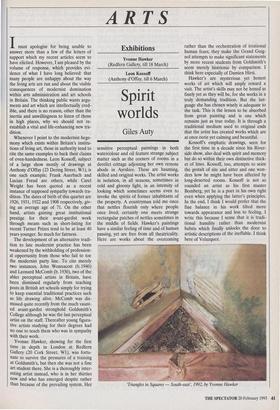ARTS
Exhibitions
Yvonne Hawker (Redfern Gallery, till 18 March) Leon Kossoff (Anthony d'Offay, till 6 March)
Spirit worlds
Giles Auty
Imust apologise for being unable to answer more than a few of the letters of support which my recent articles seem to have elicited. However, I am pleased by the volume of response, which provides evi- dence of what I have long believed: that many people are unhappy about the way the living arts are run and about the visible consequences of modernist domination within arts administration and art schools in Britain. The thinking public wants argu- ments and art which are intellectually cred- ible, and there is no reason, other than the inertia and unwillingness to listen of those in high places, why we should not re- establish a vital and life-enhancing new tra- dition.
Whenever I point to the modernist hege- mony which exists within Britain's institu- tions of living art, those in authority tend to cite the same examples to back their claims of even-handedness. Leon Kossoff, subject of a large show mostly of drawings at Anthony d'Offay (23 Dering Street, W1), is one such example; Frank Auerbach and Lucian Freud are others, while Carel Weight has been quoted as a recent instance of supposed sympathy towards tra- dition. The dates of birth of this quartet are 1926, 1931, 1922 and 1908 respectively, giv- ing an average age of 71. On the other hand, artists gaining great institutional prestige for their avant-gardist work through means such as short-listing for recent Turner Prizes tend to be at least 40 years younger. So much for fairness.
The development of an alternative tradi- tion to late modernist practice has been weakened by the withholding of profession- al opportunity from those who fail to toe the modernist party line. To cite merely two instances, John Wonnacott (b. 1940) and Leonard McComb (b. 1930), two of the abler perceptual artists in Britain, have been dismissed regularly from teaching posts in British art schools simply for trying to keep essential traditional practices such as life drawing alive. McComb was dis- missed quite recently from the much vaunt- ed avant-gardist stronghold Goldsmith's College although he was the last perceptual artist on the staff. Thereafter young figura- tive artists studying for their degrees had no one to teach them who was in sympathy with their work.
Yvonne Hawker, showing for the first time in depth in London at Redfern Gallery (20 Cork Street, W1), was fortu- nate to survive the pressures of a training at Goldsmith's, but then she was not a fine art student there. She is a thoroughly inter- esting artist instead, who is in her thirties now and who has emerged despite rather than because of the prevailing system. Her sensitive perceptual paintings in both watercolour and oil feature strange subject matter such as the corners of rooms in a derelict cottage adjoining her own remote abode in Ayrshire. These are haunting, skilled and original works. The artist works in isolation, in all seasons, sometimes in cold and gloomy light, in an intensity of looking which sometimes seems even to invoke the spirits of former inhabitants of the property. A countryman told me once that nettles flourish only where people once lived; certainly one meets strange rectangular patches of nettles sometimes in the middle of fields. Hawker's paintings have a similar feeling of time and of human passing, yet are free from all theatricality. Here are works about the overcoming rather than the orchestration of irrational human fears; they make the Grand Guig- nol attempts to make significant statements by more recent students from Goldsmith's seem merely histrionic by comparison. I think here especially of Damien Hirst.
Hawker's are mysterious yet honest works of art which will amply reward a visit. The artist's skills may not be honed as finely yet as they will be, for she works in a truly demanding tradition. But the lan- guage she has chosen wisely is adequate to the task. This is the lesson to be absorbed from great painting and is one which remains just as true today. It is through a traditional medium used to original ends that the artist has created works which are at once eerie yet calming and beautiful.
Kossoff s emphatic drawings, seen for the first time in a decade since his River- side show, also deal with spirit and memory but do so within their own distinctive thick- et of lines. Kossoff, too, attempts to seize the gestalt of site and sitter and one won- ders how he might have been affected by long-deserted rooms. Kossoff is not so rounded an artist as his first master Bomberg, yet he is a poet in his own right even when applying the latter's principles. In the end, I think I would prefer that the fine balance in his work tilted more towards appearance and less to feeling. I write this because I sense that it is tradi- tional humility rather than modernist hubris which finally unlocks the door to artistic descriptions of the ineffable. I think here of Velazquez.
`Triangles in Squares — South-east, 1992, by Yvonne Hawker


























































 Previous page
Previous page